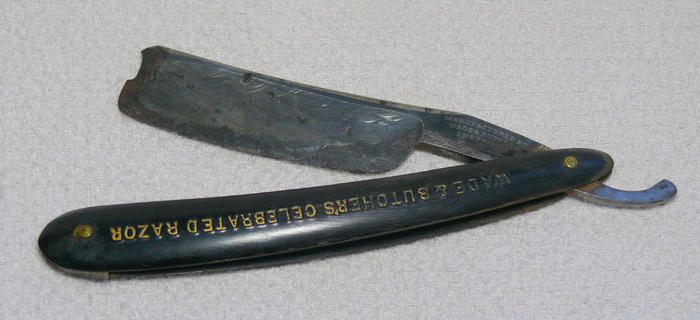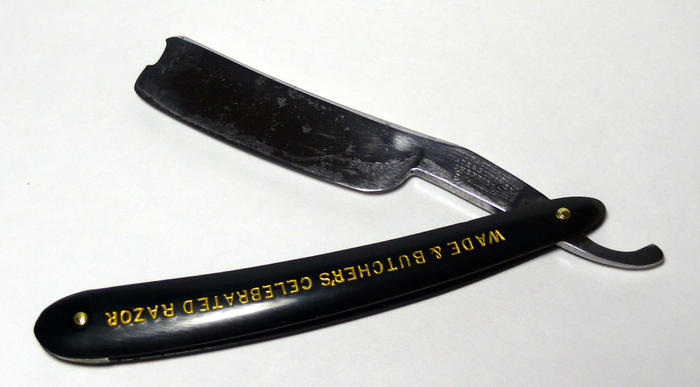Results 11 to 20 of 24
Thread: Application of Gold Leaf
-
03-23-2014, 04:41 AM #11

There is an even simpler alternative to consider: gold paint. I picked up this W&B at a flea market a couple of years ago and it too had a serious case of worn out gold. Not quite as bad as your scales, but nevertheless it needed pretty much a total re-do of the gold:

It was Rune (Zephyr) who suggested I try to paint it, and it turned out great. I used simple acrylic paint bought at an art store. It was very easy to paint into the depressions, and to wipe off any excess that got onto bits I didn't want painted.

It was in original condition, faded red, well-worn, but nice.
This was and still is my favorite combination; beautiful, original, and worn.
-Neil Young
-
03-23-2014, 04:48 AM #12

I thought the originals were hot pressed horn with gold leaf ?
But can't wait to see how it turns out either way you do itSaved,
to shave another day.
-
03-23-2014, 09:49 PM #13Member

- Join Date
- Mar 2014
- Posts
- 41
Thanked: 0
Thanks again for the replys guys. The only thing holding me back from using acrylic paint is the detail of the leaves around the border. The leaves aren't just an outline and have veins and textured stems. I'm afraid I would lose this detail. It might be possible to thin out the paint to make it more of a "wash" and just apply it in multiple coats to get a true gold color. Ill do some more research and try to work on it this weekend.
-
03-23-2014, 10:45 PM #14

True gold leaf usually comes in books with the stuff on paper. It's usually taken off applied and pressed into place. No adhesives are used. It's adheres by itself. It is usually used on decorative things and artwork where wear is not an issue. It stands up to wear very poorly.
No matter how many men you kill you can't kill your successor-Emperor Nero
-
03-23-2014, 11:05 PM #15

My only real knowledge about gold leaf application is from mediaeval manuscripts. In that context (applying leaf to parchment for decorative purposes), one of the most common approaches was to apply gesso to the page where one wanted the leaf to adhere, apply the leaf, brush off the leaf you don't want, and then burnish what was left. It works very well in terms of keeping leaf where you want it, and allowing it to be removed from other spaces, but then you're back at having to deal with the same issue i.e. brushing something (in this case gesso rather than paint) into tiny areas in a way that won't obscure details. It would also have the disadvantage of at least slightly filling the depressions you want to gild. The gesso isn't really an adhesive, but rather presents an excellent surface to which the leaf can adhere on its own. The same issues would come into play with an older mediaeval technique in which leaf was applied to a wet adhesive.
The third mediaeval manuscript technique involved what was known as 'shell gold'. It was powdered gold in a binder such as gum arabic, forming a kind of gold paint or ink.
All of which is likely not much help to anyone when it comes to razor scales. I just get excited when a mediaeval-ish topic is raised here.
It was in original condition, faded red, well-worn, but nice.
This was and still is my favorite combination; beautiful, original, and worn.
-Neil Young
-
03-23-2014, 11:45 PM #16

There are two main ways of applying gold leaf. Oil gilding and water gilding. With oil gilding the gold leaf is applied to a nearly dry oil size or varnish. Oil is more durable but more matte then water gilding. Water gilding is applied to smooth surface made up from clay and hide glue. A barely damp surface causes the gold leaf to adhere hide glue that is mixed with the clay or gesso. When you water gilding the surface can be burnished to high sheen with a burnisher.
I really think the rub n buff brand of products would work well in this case.
CharlieLast edited by spazola; 03-23-2014 at 11:48 PM.
-
The Following User Says Thank You to spazola For This Useful Post:
Cangooner (03-24-2014)
-
03-24-2014, 02:17 AM #17Member

- Join Date
- Feb 2014
- Location
- Columbus, Ohio
- Posts
- 56
Thanked: 6
I would clean the embossing and get some gold paste at hobby lobby and brush it in the stamping and wipe the excess off after it dried. IMO it would last longer than the gold leaf. There is another post on here that address this subject. Good luck with your restoration.
Last edited by bookdoctor; 03-24-2014 at 05:15 PM. Reason: new info
-
03-25-2014, 04:02 AM #18

I use a gold acrylic paint ball pen from the art store. You can get a few different colors of gold. The 14K Yellow is closest to the original.
Shake the pen well.Run a little i\on a sheet of paper to get it flowing cleanly. Then trace the design and fill it slowly. Allow it to dry. Do it again in any low spots. Dry it. Then carefully sand it to the surrounding surface if it high and assure the surface around it is clean and smooth. High grit sandpaper is best.

Have fun!
~Richard
Thanks to the rest of you for ideas and possibilities. Some will work well for raised lettering! Be yourself; everyone else is already taken.
Be yourself; everyone else is already taken.
- Oscar Wilde
-
03-28-2014, 08:59 PM #19Member

- Join Date
- Mar 2014
- Posts
- 41
Thanked: 0
Wow that looks great. Did you use anything to seal it afterwards?
-
03-28-2014, 10:18 PM #20

The paint dries like a regular hobby model paint and it has shown no signs of needing a sealer.
~RichardBe yourself; everyone else is already taken.
- Oscar Wilde


 28Likes
28Likes LinkBack URL
LinkBack URL About LinkBacks
About LinkBacks












 Reply With Quote
Reply With Quote



